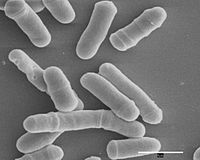
Photo from wikipedia
Abstract Non-coding RNAs (ncRNAs) ubiquitously exist in normal and cancer cells. Despite their prevalent distribution, the functions of most long ncRNAs remain uncharacterized. The fission yeast Schizosaccharomyces pombe expresses >1800… Click to show full abstract
Abstract Non-coding RNAs (ncRNAs) ubiquitously exist in normal and cancer cells. Despite their prevalent distribution, the functions of most long ncRNAs remain uncharacterized. The fission yeast Schizosaccharomyces pombe expresses >1800 ncRNAs annotated to date, but most unconventional ncRNAs (excluding tRNA, rRNA, snRNA and snoRNA) remain uncharacterized. To discover the functional ncRNAs, here we performed a combinatory screening of computational and biological tests. First, all S. pombe ncRNAs were screened in silico for those showing conservation in sequence as well as in secondary structure with ncRNAs in closely related species. Almost a half of the 151 selected conserved ncRNA genes were uncharacterized. Twelve ncRNA genes that did not overlap with protein-coding sequences were next chosen for biological screening that examines defects in growth or sexual differentiation, as well as sensitivities to drugs and stresses. Finally, we highlighted an ncRNA transcribed from SPNCRNA.1669, which inhibited untimely initiation of sexual differentiation. A domain that was predicted as conserved secondary structure by the computational operations was essential for the ncRNA to function. Thus, this study demonstrates that in silico selection focusing on conservation of the secondary structure over species is a powerful method to pinpoint novel functional ncRNAs.
Journal Title: Nucleic Acids Research
Year Published: 2022
Link to full text (if available)
Share on Social Media: Sign Up to like & get
recommendations!